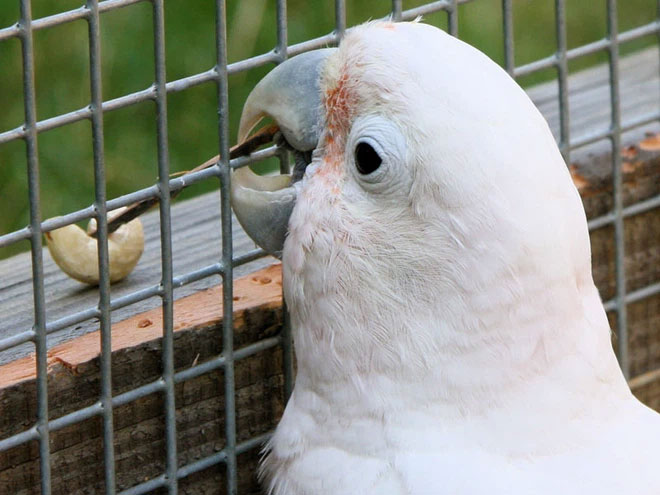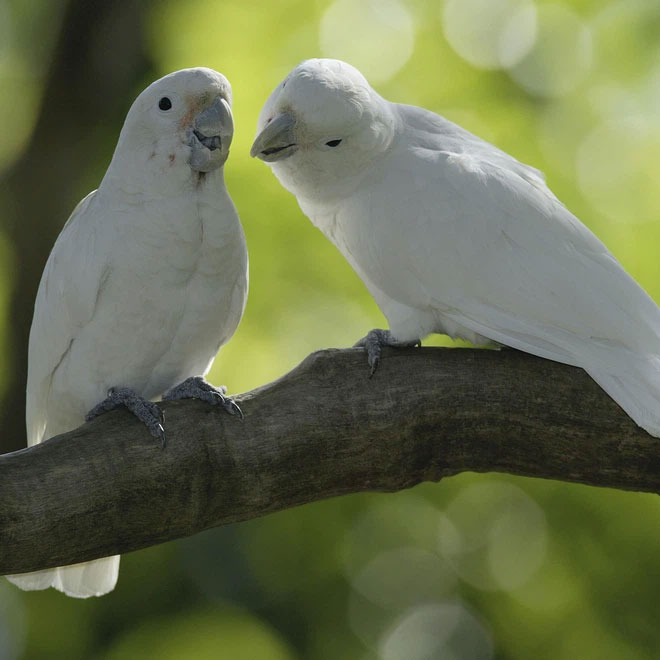The Goffin’s cockatoo (scientific name Cacatua goffiniana) has an intelligence level comparable to that of a 3-year-old child. But throughout human history, have we ever seen a 3-year-old child crafting their own knives and spoons for meals?
Scientists have observed wild cockatoos and discovered that they create tools similar to crowbars, shovels, and spoons to extract the seeds from their favorite fruits. This is the first time researchers have found a bird species that crafts and uses tools in sets. This behavior has previously only been observed in humans, chimpanzees, and capuchin monkeys.
The Goffin’s cockatoo uses fine tools, medium-sized tools, and sturdy tools to extract the seeds from wawai fruits.
According to Alex Taylor, a biologist specializing in corvids at the University of Auckland, the new research “supports the idea that parrots possess a widespread intelligence that allows them to devise creative solutions to problems they encounter in the wild,” while also pointing out that “this is one of the most effective tool-using wild bird species.”
The discovery of this ability was made by behavioral ecologist Mark O’Hara during a research trip in Indonesia. “Just turning around, I immediately caught sight of one of the cockatoos crafting and using tools. I couldn’t believe my eyes!,” he recalled excitedly.
The Goffin’s cockatoo is known for its cleverness and good communication skills. In laboratory settings, these parrots have solved puzzles set by researchers and have crafted tools resembling rakes from collected materials. While many bird species can craft and use tools in the wild, none have shown the ability to create a set of tools.

Previous research shows Goffin’s cockatoos can create food-picking sticks.
In the new study, O’Hara and his team traveled to Tanimbar Island to observe the cockatoos, but the wild animals were not very interested in science. The birds lived high in the treetops, making observation difficult, and throughout 900 hours of video footage, the Goffin’s cockatoos did not use tools even once.
To expedite the research, the team brought 15 cockatoos back to the laboratory, planning to observe them for a few months before releasing them. With their curved and strong beaks, Goffin’s cockatoos can eat a wide variety of fruits. They are undeterred by papayas or young coconuts and can use their beaks to drill through the tough skins. “They love to play, picking up and chewing on small sticks, but with no specific purpose,” O’Hara said.
Then came the fateful day in June 2019 when O’Hara was observing wild cockatoos in the forest and noticed a fruit that had fallen to the ground with beak marks on it. A member of the research team, who was also a local, identified the egg-shaped object as a sea mango, or “wawai” in the local dialect, which had just entered its fruiting season. Wawai is roughly the size of a small avocado and is toxic to humans, but clearly, the cockatoos can still eat it.
O’Hara brought the wawai back for the 15 cockatoos in the laboratory and observed their reactions. Inside the reddish skin, the thick flesh contained a hard seed with rich nutrients. Accessing the seed was quite difficult, even for the cockatoo’s strong beak.
O’Hara was astonished to see a male cockatoo using its beak to scrape the skin, plucking a small twig from a tree, and continuously pecking at it to give it a certain “sharpness.” Holding the fruit with its left foot and balancing with its right, the cockatoo used its tongue to insert the newly crafted tool into the seed cavity and pry off the skin. Next, the cockatoo fashioned a small, thin tool to pierce the seed’s protective layer. Finally, it created a thin wooden tool resembling a spoon to scoop out the seed.

Goffin’s cockatoo.
The research team provided the cockatoos with a large quantity of fruit, but only two males crafted and used tools to eat the seeds. “If this tool-using tendency is genetically predisposed, then any cockatoo would have done it by now,” researcher O’Hara stated. “Since only a few were able to create tools, it’s likely that the cockatoos invented them themselves.” He added that it’s possible the cockatoos learned from their peers while living in the wild.
Among the captured birds, most of the other cockatoos were still young but were curious about the older individuals. They picked up the tools to play with, but perhaps the young cockatoos were still too small to extract the seeds for themselves. “We know they communicate with each other in captivity, likely doing the same in the wild,” said Berenika Mioduszewska, a neuroscientist and co-author of the study.
Since discovering the cockatoos’ wooden tools, the research team has found other wawai fruits not only scratched but also impaled by tools. Could we be on the verge of a new field, archaeology, but for birds?
















































